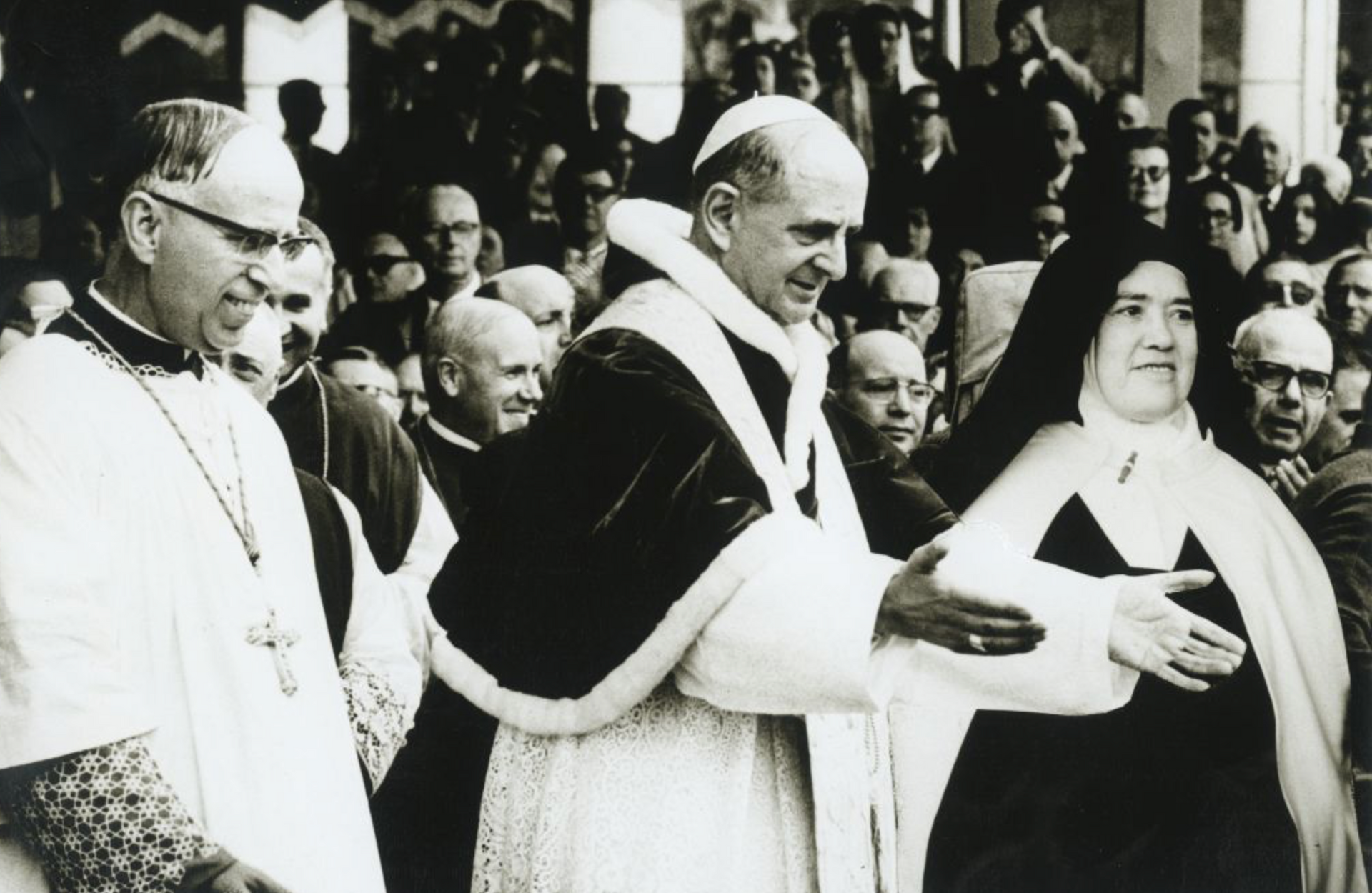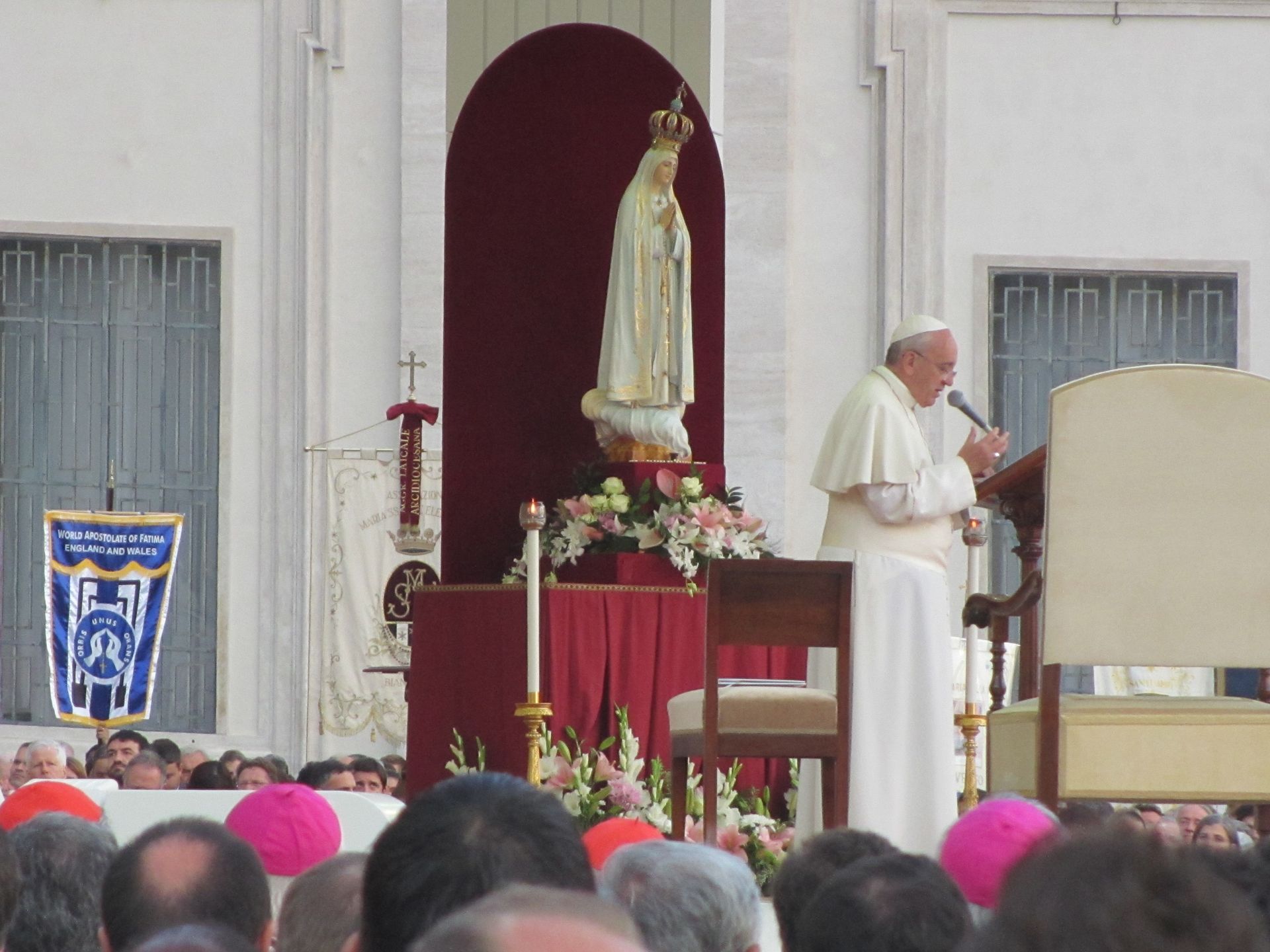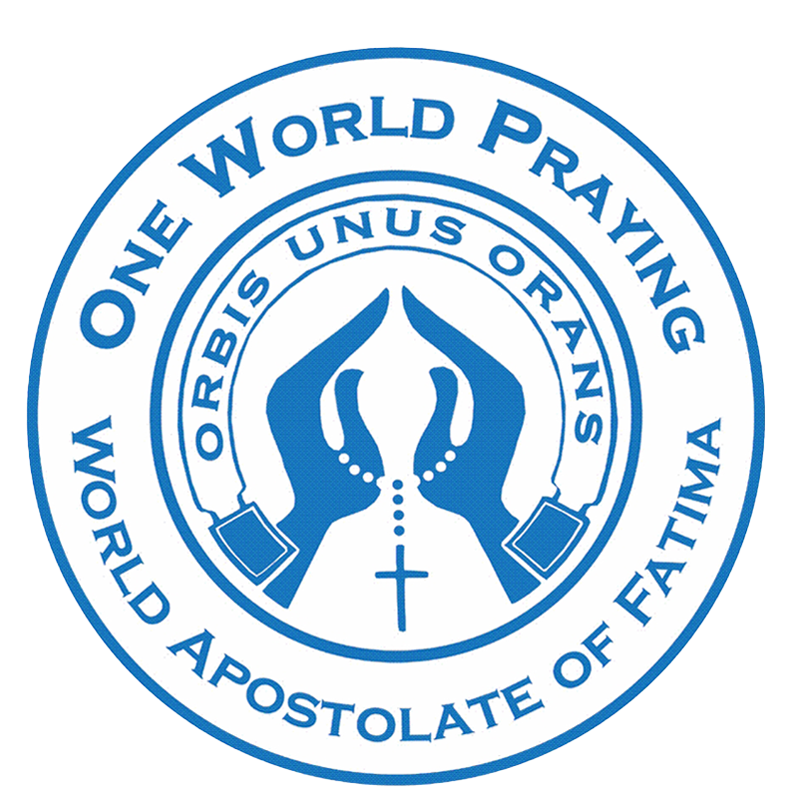The Third Part of the Fatima Secret
Pope St. John Paul II announced at Fatima on 13 May 2000 that the text of the third part of the secret of Fatima would be released by the Congregation for the Doctrine of the Faith “after the preparation of an appropriate commentary [and] in order that the faithful may better receive the message of Fatima”.
In announcing its forthcoming publication at the direction of Pope St. John Paul II, Cardinal Sodano said that it concerned “above all the war waged by atheistic systems against the Church … the immense suffering endured by witnesses of the faith … an interminable Way of the Cross led by the Popes of the 20th century”.
Sr Lucia describes how in the vision they saw a bishop dressed in white, which she understood was the Holy Father, with clerics and religious, passing through a half ruined city and going up a steep mountain “at the top of which there was a big Cross of rough-hewn trunks”. The Pope prayed for the dead on his way there, much afflicted and moving slowly, and was killed at the top by soldiers, as were the clerics, religious and lay people with him.
On 26 June 2000, Cardinal Ratzinger, later Pope Benedict XVI, published the full text of the third part of the secret, together with his own Theological Commentary, with many important insights into its meaning and significance for the Church. This was issued in a 21-page document entitled The Message of Fatima, which also contained a quantity of supporting documentation. On the same day it was made immediately available on the Vatican website, where it can be read at:
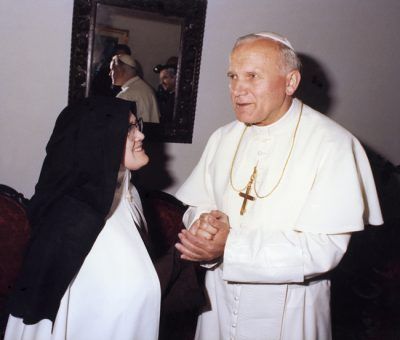
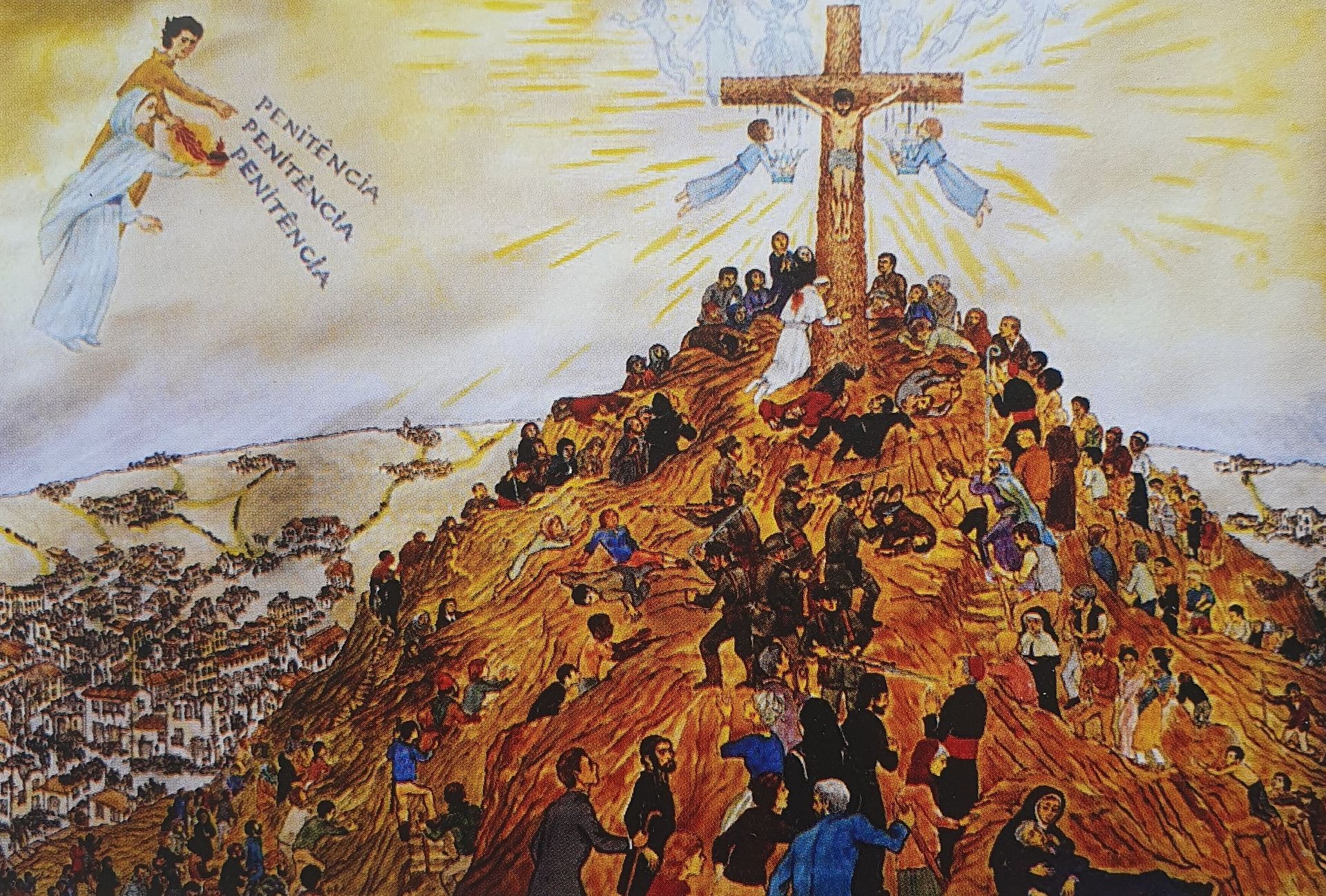
Sr Lucia later affirmed, when she was shown the hand-written text of the vision, that she recognised it as the one she had written down in 1944, and contrary to some erroneous allegations, that that was the complete text of the vision, and there were no further secrets to be revealed.
Also, in her third memoir, she tells us about two incidents in which Jacinta saw visions of a future Pope, and these also relate to the secret.
One day, while they were near the well at Lucia’s home, Jacinta asked her if she had seen the Holy Father. When Lucia replied, “No,” Jacinta said: “I don’t know how it was, but I saw the Holy Father in a very big house, kneeling by a table, with his head buried in his hands, and he was weeping. Outside the house, there were many people. Some of them were throwing stones; others were cursing him and using bad language. Poor Holy Father, we must pray very much for him.”
Sr Lucia then tells us: “At another time, we went to the cave called Lapa do Cabeço. As soon as we got there, we prostrated on the ground, saying the prayers the Angel had taught us. After some time, Jacinta stood up and called to me: ‘Can’t you see all those highways and roads and fields full of people, who are crying with hunger and have nothing to eat? And the Holy Father in a church praying before the Immaculate Heart of Mary? And so many people praying with him?’ Some days later, she asked me: ‘Can I say that I saw the Holy Father and all those people?’ ‘No. Don’t you see that that’s part of the secret? If you do, they’ll find out right away.’ ”
During his homily at the Mass for the beatification of Francisco and Jacinta at Fatima on 13 May 2000, St John Paul II expressed his personal gratitude to Blessed Jacinta for the sacrifices and prayers she had offered for the Holy Father, “whom she saw suffering greatly”.
This is how Sr Lucia described the vision that she saw in the third part of the secret:
“After the two parts which I have already explained, at the left of Our Lady and a little above, we saw an Angel with a flaming sword in his left hand; flashing, it gave out flames that looked as though they would set the world on fire; but they died out in contact with the splendour that Our Lady radiated towards him from her right hand: pointing to the earth with his right hand, the Angel cried out in a loud voice: ‘Penance, Penance, Penance!’. And we saw in an immense light that is God: ‘something similar to how people appear in a mirror when they pass in front of it ...’
“... a Bishop dressed in White; ‘we had the impression that it was the Holy Father’. Other Bishops, Priests, men and women Religious going up a steep mountain, at the top of which there was a big Cross of rough-hewn trunks as of a cork-tree with the bark; before reaching there the Holy Father passed through a big city half in ruins and half trembling with halting step, afflicted with pain and sorrow, he prayed for the souls of the corpses he met on his way; having reached the top of the mountain, on his knees at the foot of the big Cross he was killed by a group of soldiers who fired bullets and arrows at him, and in the same way there died one after another the other Bishops, Priests, men and women Religious, and various lay people of different ranks and positions. Beneath the two arms of the Cross there were two Angels each with a crystal aspersorium in his hand, in which they gathered up the blood of the Martyrs and with it sprinkled the souls that were making their way to God.”
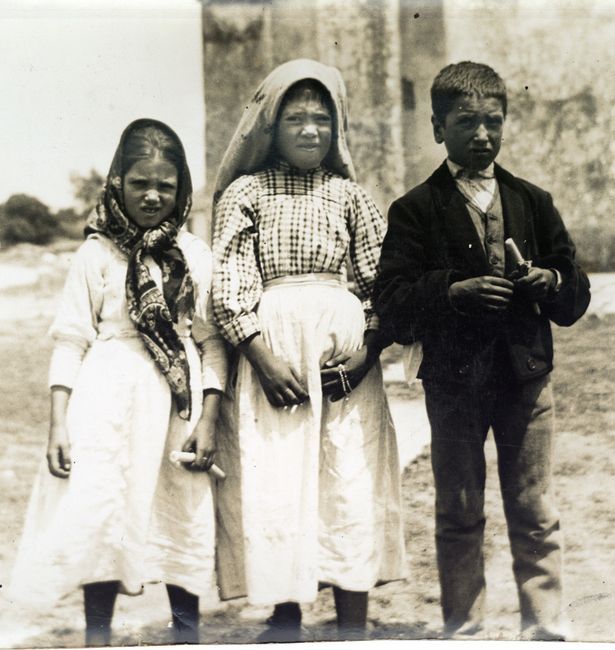
The third part of the secret fully revealed
There has been some controversy about this, with some people claiming that the full text of the third part of the secret has not been revealed. However, this is what Pope Benedict XVI said, when, as Cardinal Ratzinger, he was asked to write a theological commentary on the secret in June 2000. In this he stated that for the first time the third part of the secret was “being published in its entirety.”
CLARIFICATION ON ALLEGED SECOND TEXT
On the question of the existence of an alleged second text of the third part of the secret, Our Lady told Sr Lucia to write
down what her superiors commanded of her, but not what she was given to understand of its meaning. So there was a distinction between what Sr Lucia saw in the vision of 13 July 1917, and how she was made to understand that vision.
Since Our Lady expressly told Sister not to write down what she understood of the vision’s meaning then there is no second text,
and so there cannot be any cover-up of a non-existent document.
For more information, see more here.
FATIMA AFTER THE APPARITIONS
Meanwhile, work on the construction of the Capelinha, the Chapel of Apparitions, began on 28 April 1919 and was completed on 15 June; the first Mass was celebrated there on 13 October 1921. The pedestal on which the image of Our Lady stands in the Capelinha marks the exact spot where the little holm oak grew on which Our Lady appeared. In May 1922, Bishop Jose Correia da Silva of Leiria-Fatima, named a commission of enquiry to analyse the facts surrounding the Fatima phenomenon “with strictness and impartiality”.
On 10 December 1925, Sr Lucia, who had become a postulant with the Dorothean Sisters, was at their convent in Pontevedra, Spain, when she saw another apparition, this time of Mary with the Child Jesus. Mary told Lucia that she promised all the graces necessary for salvation to those who, on the first Saturday of five consecutive months, confessed, received Holy Communion, recited five decades of the rosary, and meditated on the rosary for fifteen minutes, all with the intention of making reparation to her Immaculate Heart.
Meanwhile, on 13 January 1924, Mass was celebrated for the first time inside the Capelinha, while on 26 June 1927, the bishop presided for the first time at an official event—the inauguration of the 14 kilometre Way of the Cross to the Cova da Iria, where he celebrated Mass in the presence of 400 pilgrims. Building work on he Basilica of Our Lady of the Rosary of Fatima was begun in 1928, and it was consecrated on 7 October 1953. It has 15 altars dedicated to the 15 mysteries of the Rosary. The bodies of Jacinta and Francisco were moved to their present positions, to the left and right of the main altar, in the early 1950s, and Sr Lucia’s body was interred in the Basilica in 2008 next to Jacinta’s. The mortal remains of Bishop Correia da Silva, who died in 1957, are interred in the Chancel.
Prior to this, on 13 June 1929 Sr. Lucia, while at prayer in the convent chapel at Tuy, saw a vision of the Most Holy Trinity, with Mary standing on the altar displaying her Immaculate Heart in her left hand. It was on this occasion that Mary asked the Pope, in union with all the bishops of the world, to make the [collegial] consecration of Russia to her Immaculate Heart that she had announced during the July 1917 apparition.
On 13 October 1930 the Bishop issued a pastoral letter on the apparitions, which, after recounting the events at Fatima, contained the following brief but important statement:
“In virtue of considerations made known, and others which for reasons of brevity we omit; humbly invoking the Divine Spirit and placing ourselves under the protection of the most Holy Virgin, and after hearing the opinions of our Rev. Advisors in this diocese, we hereby:
- Declare worthy of belief, the visions of the shepherd children in the Cova da Iria, parish ofFatima, in this diocese, from the 13th May to13th October, 1917.
- Permit officially the cult of Our Lady of Fatima.”
In thanksgiving for this development, six months later, on 13 May 1931, a vast pilgrimage of around 300,000 people came to Fatima to participate in a ceremony presided over by Cardinal Cerejeira, Patriarch of Lisbon, at which all the bishops of Portugal made the first consecration of their country. It was this consecration, and that of 1938, which preserved Portugal from the violent attack on the Church in the Spanish Civil War, and its renewal in 1940 saved Portugal from being dragged into the horrors of the Second World War.
Fatima developments from World War II onwards
On 31 October 1942, during World War II, Pope Pius XII, speaking in Portuguese by radio, consecrated the world to the Immaculate Heart of Mary, with a special mention of Russia, in response to the request he had received in a letter from Sr Lucia. Some months later Sr Lucia said that as a result of this act, God promised to end the war soon.
On 13 May 1946, Cardinal Masella, the Papal Legate, crowned the Statue of Our Lady of Fatima in the Capelinha as Queen of Peace. This crown was made from gold melted down from wedding rings donated by the women of Portugal, and it also contains over 4,000 precious stones, which they contributed in thanksgiving for Portugal having been spared the horrors of the Spanish Civil War and the Second World War.
On 13 October 1951, Cardinal Tedeschini, who was in Fatima for the closing of the Holy Year, revealed that in October 1950, at the time when he had promulgated the dogma of Mary’s Assumption into heaven, Pope Pius XII had witnessed a repetition of the solar miracle of 13 October 1917, while he was walking in the Vatican gardens.
Cardinal Roncalli, the Patriarch of Venice, and the future Pope John XXIII, presided at the ceremonies at Fatima on 13 May 1956, while, on 21 November 1964, Pope Paul VI, at the conclusion of the third session of the Second Vatican Council, proclaimed “the Most Blessed Mary Mother of the Church”; the Pope also considered it was “particularly opportune” to recall Pius XII’s consecration of the world to the Immaculate Heart of Mary; and bearing that consecration in mind, he announced before the 2,500 Council Fathers, that a Golden Rose was to be presented to the Sanctuary of Fatima (this act was carried out on 13 May 1965 by Cardinal Cento, the Papal Legate); and the Pope concluded his address by proclaiming, “to your Immaculate Heart, O Mary, we commend the entire human race”.
Pope Paul VI came to Fatima on 13 May 1967 to celebrate the 50th anniversary of Our Lady’s first Apparition, and to pray for world peace and Church unity. In a significant sign of papal approval for the message of Fatima, the Pope invited Sr Lucia to join him on the external altar in front of the crowds, and in his Apostolic Exhortation Signum Magnum, issued on the same day, Paul VI urged “all members of the Church to consecrate themselves once again to the Immaculate Heart of Mary and to translate this pious act into their daily lives”.
Ten years later, on 10 August 1977, the future Pope John Paul I, Cardinal Luciani, Patriarch of Venice, came on pilgrimage to Fatima.

